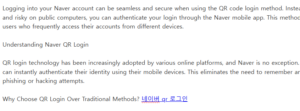Logging into your Naver account can be seamless and secure when using the QR code login method. Instead of typing your ID and password, which can be time-consuming and risky on public computers, you can authenticate your login through the Naver mobile app. This method enhances security while also providing a convenient experience for users who frequently access their accounts from different devices.
Understanding Naver QR Login

QR login technology has been increasingly adopted by various online platforms, and Naver is no exception. By scanning a unique QR code generated on the login page, users can instantly authenticate their identity using their mobile devices. This eliminates the need to remember and input passwords manually, which significantly reduces the risk of phishing or hacking attempts.
Why Choose QR Login Over Traditional Methods? 네이버 qr 로그인
Traditional login methods require you to input your credentials manually, which can expose your password to keyloggers or malicious software. On the other hand, QR login bypasses this risk by directly linking your login session to an authenticated mobile device. Furthermore, it provides an added layer of protection since access approval must be granted from your registered mobile app.
How to Enable Naver QR Login 윤과장의 소소한 일상 이야기
If you are new to QR login, setting up this feature is straightforward. First, ensure that you have installed the Naver app on your smartphone. This app serves as the primary tool for scanning and approving login requests. Once you have the app installed and are logged in, navigate to the QR login option when accessing Naver on a PC.
After selecting the QR login option, a unique QR code will appear on the screen. Open the Naver app, find the QR scanner, and scan the displayed code. Your mobile device will then prompt you to confirm the login attempt. Approving this request will instantly log you into your Naver account on your PC without requiring a password.
Benefits of Using Naver QR Login
One of the main benefits of QR login is the enhanced security it provides. Since there is no need to type your password, the risk of credential theft is significantly minimized. Additionally, QR login is an excellent solution for users who frequently forget their passwords, as it removes the need for constant resets.
Another advantage is convenience. Since you only need your smartphone for authentication, logging in becomes a fast and effortless process. This is particularly useful for users who access their accounts from different devices, such as work computers, public terminals, or borrowed laptops.
Common Issues and Troubleshooting Methods
While QR login is generally smooth and efficient, some users may encounter issues. The most common problem is an expired QR code, which occurs if too much time passes before scanning. To resolve this, simply refresh the page to generate a new code.
Another common issue is an unresponsive QR scanner. If your Naver app does not scan the code properly, ensure that your app is updated to the latest version. Restarting your mobile device or clearing the app’s cache may also help resolve scanning issues.
Ensuring Maximum Security with QR Login
Although QR login enhances security, users should still follow best practices to protect their accounts. Always ensure that your smartphone has a strong password or biometric lock enabled. Additionally, avoid scanning QR codes from untrusted sources, as some phishing attacks attempt to mimic legitimate QR login screens.
For added protection, enable two-factor authentication (2FA) on your Naver account. This extra layer of security ensures that even if someone gains access to your mobile device, they will still need additional verification to log in.
Comparing QR Login with Other Authentication Methods
Besides QR login, Naver offers several authentication options, including password login, social media login, and biometric authentication. While each method has its own advantages, QR login stands out due to its combination of speed and security. Unlike passwords, which can be guessed or stolen, QR login relies on an encrypted mobile authentication process.
Social media login, while convenient, may not always be the safest choice, as it links your Naver account to an external platform. Biometric authentication is another secure option, but it requires a compatible device with fingerprint or facial recognition capabilities. Ultimately, QR login provides an optimal balance between ease of use and robust security.
Future of QR Login Technology
As digital security threats continue to evolve, QR login technology is expected to improve even further. Future enhancements may include AI-driven security checks, automatic logout features, and integration with multi-device authentication systems. Naver is likely to continue refining its QR login process to ensure the safest and most efficient experience for users.
For users who prioritize both convenience and security, Naver QR login is an excellent choice. With simple setup procedures, fast authentication, and enhanced protection against cyber threats, this login method is quickly becoming a preferred option among users worldwide.
If you have yet to try QR login, now is the perfect time to enable this feature and experience a smarter way to access your Naver account. Not only will you save time, but you will also enhance your online security effortlessly.